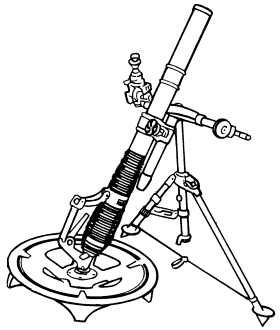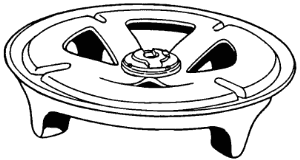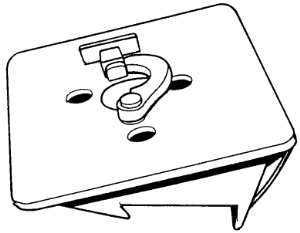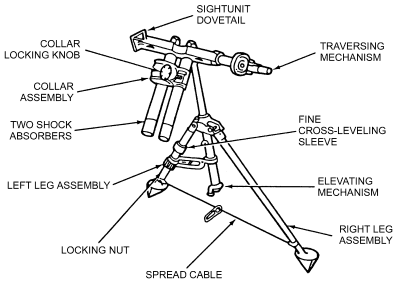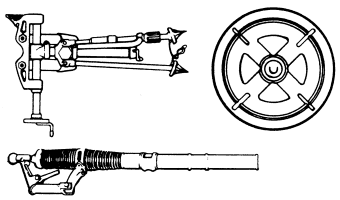| TECHNICAL DATA |
|---|
| Complete System |
|---|
| Country of Origin | USA |
|---|
| Date Of Introduction | 1978 |
|---|
| Crew | 3 |
|---|
| Caliber | 2.4 in (60 mm) |
|---|
| Weight | 46.5 lb (21.1 kg) Conventional Mode
18.0 lb (8.2 kg) Handheld Mode |
|---|
| Range | 77 - 3,828 yd (70 - 3,500 m) |
|---|
| Rate of Fire | Maximum: 18-30 per minute for 1 to 4 minutes
Sustained: 8-20 rounds per minute, indefinitely |
|---|
| Unit Replacement Cost | $10,658 |
|---|
| M225 Cannon |
|---|
| Weight | 18.0 lb (8.2 kg) Conventional Mode
14.4 lb (6.5 kg) Handheld Mode |
|---|
| M7 Baseplate |
|---|
| Weight | 14.4 lb (6.5 kg) |
|---|
| M8 Baseplate |
|---|
| Weight | 3.6 lb (1.6 kg) |
|---|
| M170 Bipod Assembly |
|---|
| Weight | 15.2 lb (6.9 kg) |
|---|
| Traverse | 250 mils |
|---|
| M64-Series Sightunit |
|---|
| Weight | 2.5 lb (1.1 kg) |
|---|
| Length | 4.375 in (111 mm) |
|---|
| Width | 4.75 in (121 mm) |
|---|
| Height | 7.375 in (187 mm) |
|---|
| Field of View | 17° (302 mils) |
|---|
| Magnification | 1.5 unity power |
|---|
| Light Source | Self-contained, radioactive tritium gas (H3) |
|---|
DESCRIPTION
The M224 60mm mortar is a muzzle-loaded, smooth-bore, high-angle-of-fire weapon. The mortar can be fired in the conventional mode or handheld mode.
It can be drop-fired or trigger-fired.
The M224 provides air assault, airborne, ranger, and light infantry rifle companies with an effective, efficient, and flexible weapon.
The inherent limitations of a light mortar (short-range and small-explosive charge) can be minimized by careful planning and a thorough knowledge of its capabilities.
The M224 can be employed in several different configurations. The lightest weighs about 18 pounds; the heaviest weighs about 45 pounds. Each round weighs about 4 pounds.
The mortar can be fired accurately with or without a fire direction center.
The short minimum range of the M224 makes the mortar well suited for close protective fires against an assaulting enemy, for block-to-block fighting in cities, and combat over close terrain with restricted visibility.
M225 Cannon Assembly
The cannon assembly has one end closed by a base cap.
The base cap end of the cannon has cooling fins on the outside, which reduce heat generated during firing.
Attached to the base cap end is a combination carrying handle and firing mechanism.
The carrying handle has a trigger, firing selector, range indicator, and auxiliary carrying handle.
On the outside of the barrel is an upper and a lower firing saddle.
The lower saddle is used when firing at elevations of 1100 to 1511 mils; the upper saddle is used when firing at elevations of 0800 to 1100 mils.
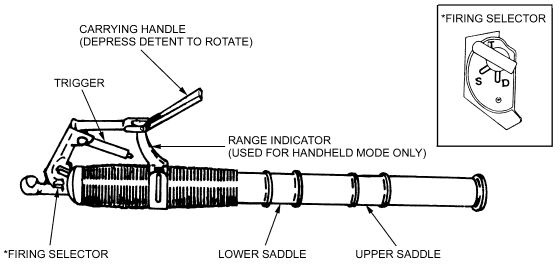
BASEPLATES
The M7 baseplate is a one-piece, circular, aluminum-forging base.
It has a ball socket with a rotating locking cap and a stationary retaining ring held in place by four screws and lock washers.
The locking cap rotates 6400 mils, giving the mortar full-circle firing capability. The underside of the baseplate has four spades to stabilize the mortar during firing.
The M8 baseplate is a one-piece, rectangular, aluminum-forging base. It should be used when the mortar is fired in the handheld mode.
The lightweight M8 baseplate is used most often during offensive operations.
The baseplate allows the mortar to be fired 0800 mils left and 0800 mils right of the center of sector for a total sector coverage of 1600 mils.
It has a socket in which the barrel can be locked to the baseplate by securing the locking arm.
The underside of the baseplate has four spades to strengthen and stabilize the mortar during firing. Two spring-loaded plungers lock the baseplate to the barrel in its carry position.
M170 Bipod Assembly
The M170 can be assembled to the barrel either before or after assembly of the barrel to the baseplate.
M64-Series Sightunit
The sightunit is the device on which the gunner sets deflection and elevation to hit targets by using the elevation level vial and the cross-level vial.
After the sight has been set for deflection and elevation, the mortar is elevated or depressed until the elevation bubble on the sight is level.
The mortar is then traversed until a proper sight picture is seen (using the aiming posts as the aiming point) and cross-level bubble is level.
The mortar is laid for deflection and elevation when all bubbles are level. After the ammunition has been prepared, it is ready to be fired.
The two major components are the elbow telescope and sight mount. The elbow telescope has an illuminated cross line.
The sight mount has a dovetail, locking knobs, control knobs, scales, cranks, and locking latch.
AMMUNITION
The following are authorized Standard A cartridges for the M224 60mm mortar:
- High explosive: M720, M888, and M49A4.
- White phosphorus: M302A1, M302A2, and M722.
- Illuminating: M83A3 and M721.
- Training practice: M69TP, M50A3, and M766 (SRTR).
The ammunition designed for the WWII era M2 and M19 mortars can be fired from the M224 mortar. Standard A ammunition for the
M2 and M19 mortars is standard B for the M224 mortar. When fired from the M224 mortar, greater ranges are achieved than those
shown in the M2 and M19 firing tables.
- High explosive: M49.
- White phosphorus: M302.
- Illuminating: M83 and M721.
- Training practice: M50.
Click here for more information.
ORGANIZATION
U.S. Army light mortar sections consist of two squads, each consisting of one mortar and its crew.
The equipment carried by the mortar section allows the section to perform all the functions of an indirect fire team.
Section members are armed for self-protection with M16 rifles (section sergeant and squad leader) or pistols (gunners and ammunition bearers).
Each squad is equipped with a complete M224 mortar (baseplates, barrel, bipod, sight, and aiming stakes),
fire control equipment (binoculars, M2 compass, mortar ballistic computer, and plotting board), and a TA-1 telephone. The section sergeant has a boresight device and a radio.
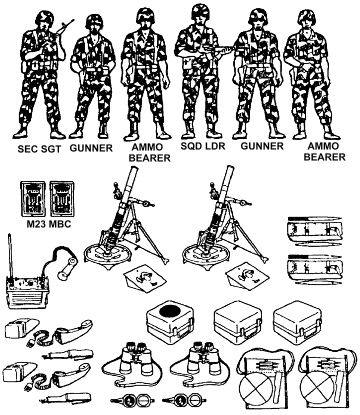
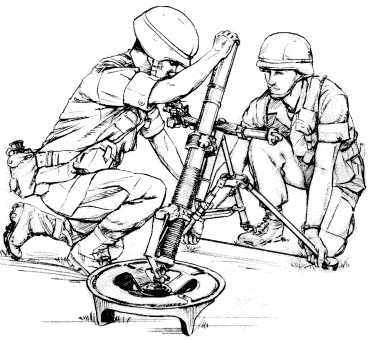
The mortar squad consists of three soldiers. Each squad member is cross-trained to perform all duties involved in firing the mortar.
The positions and principal duties are as follows:
- The squad leader is in position to best control the mortar squad. He is positioned to the right of the mortar, facing the barrel. He is also the FDC (fire direction center).
- The gunner is on the left side of the mortar where he can manipulate the sight, elevating gear handle, and traversing assembly wheel. He places firing data on the sight and lays the mortar for deflection and elevation. Assisted by the squad leader (or ammunition bearer), he makes large deflection shifts by shifting the bipod assembly.
- The ammunition bearer is to the right rear of the mortar. He prepares the ammunition and assists the gunner in shifting and loading the mortar. He swabs the barrel every 10 rounds or after each end of mission.

In the attack or movement to contact, the larger M7 baseplate can be left at the trains location and brought forward later.
The smaller M8 baseplate is lighter by 11 pounds, which allows the crew to carry three more rounds for each mortar.
If a mortar squad is attached to a platoon conducting a combat patrol, the squad leader can choose to carry only the mortar cannon and the M8 baseplate.
This is the lightest combination possible, weighing only 18 pounds. The mortar is then fired using the direct-lay, hand-held mode.
FIRING
The 60mm mortar section can quickly fire large amounts of ammunition.
The M224 can fire 120 rounds in four minutes - a three-man crew can have 15 to 20 rounds in the air before the first round impacts.
The high rate of fire is due to the simplicity of the mortar and its lightweight ammunition.
The cooling fins at the base of the mortar allow the high rate of fire to be maintained for long periods.
In the past, mortar crews, trying to produce and maintain a high rate of fire, have used the two-man loading method.
This method should not be used; it increases the chances of double-loading the mortar and causing an in-bore premature detonation.
A single loader can fire almost as fast with less chance of double-loading.
If a high rate of fire is required and ammunition is available, the squad leader can assist the ammunition bearer in preparing rounds.
With practice, they can establish a smooth flow of rounds.

More M224 Art


